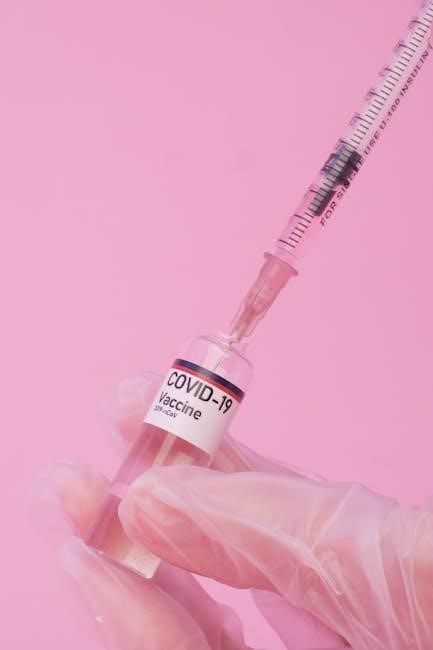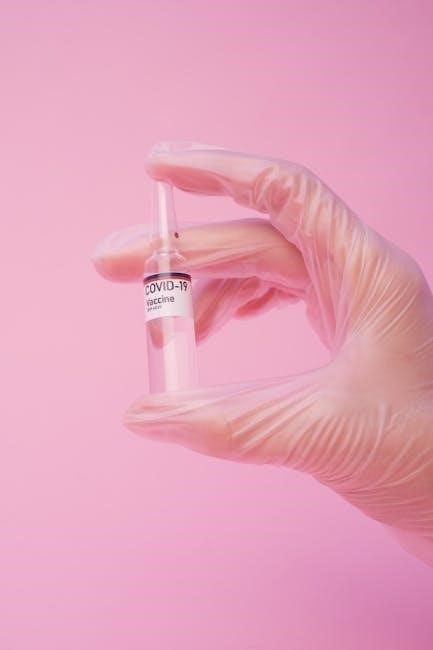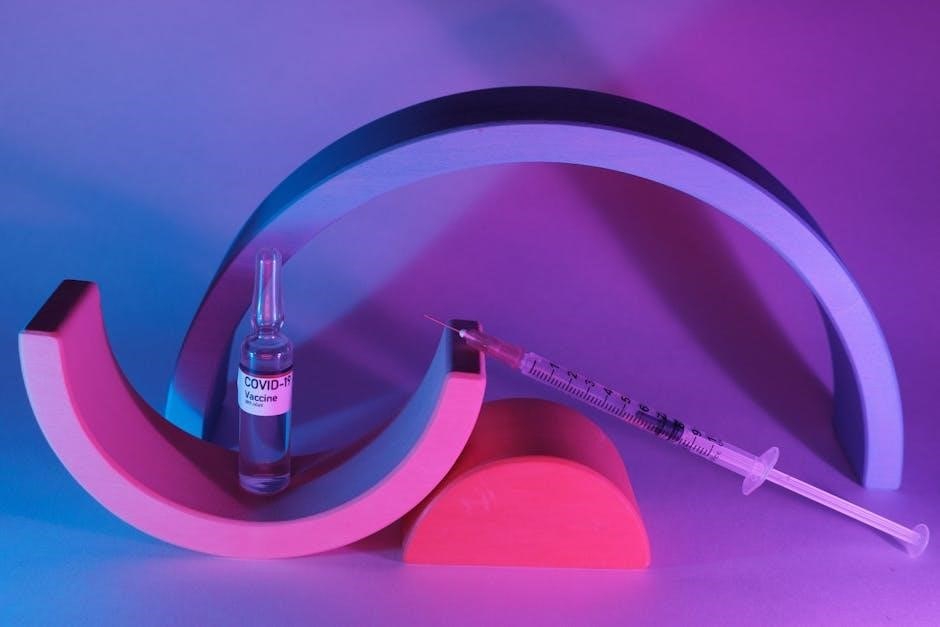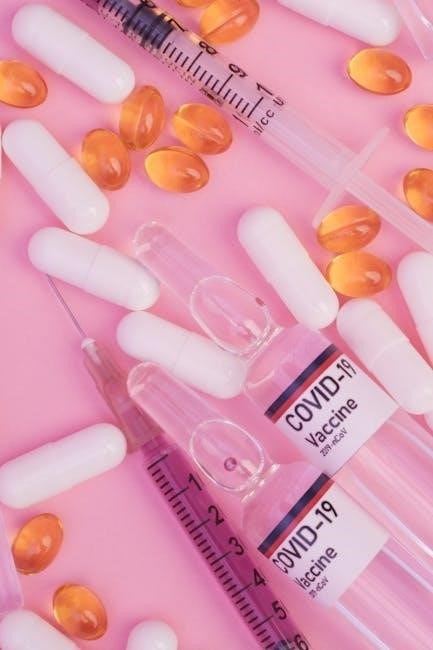injection molding defects causes and remedies pdf
Injection molding is a widely used manufacturing process for producing plastic parts, offering high efficiency and versatility. However, defects can arise, impacting product quality. This section explores the causes of such defects, such as improper processing parameters or material issues, and provides practical remedies to ensure optimal results.
1.1 Overview of the Injection Molding Process
Injection molding is a manufacturing process where molten plastic is injected into a mold cavity to produce precise plastic parts. It involves an injection unit, a clamping unit, and a mold. The process includes injecting molten material into the mold cavity, allowing it to cool and solidify, and then ejecting the part. This method is highly efficient and versatile, enabling the creation of complex shapes with high precision. Widely used across industries like automotive, healthcare, and consumer goods, injection molding ensures consistent production of high-quality plastic components.
1.2 Importance of Quality Control in Injection Molding
Quality control is crucial in injection molding to ensure defect-free production and maintain product functionality. Defects like flash, short shots, and warpage can arise from improper processing parameters, material contamination, or mold design flaws. Implementing robust quality measures helps identify and address these issues early, minimizing waste and production downtime. By optimizing processing conditions, improving material quality, and ensuring proper mold maintenance, manufacturers can enhance product reliability and meet industry standards. Effective quality control strategies are essential for delivering consistent and high-quality plastic parts in various applications.

Common Injection Molding Defects
Common injection molding defects include flash, short shots, sink marks, warpage, weld lines, burning, discoloration, mold stains, and splay or mica flakes, each impacting part quality.
2.1 Flash or Burrs
Flash or burrs occur when excess material seeps out of the mold cavity, typically along the parting line or inserts. This defect is often caused by excessive injection pressure, improper clamping force, or mold wear. To address this issue, it is recommended to fine-tune the injection pressure, regularly inspect and maintain the mold, and adjust the clamping force as needed. Ensuring proper mold alignment and polishing the mold surfaces can also help prevent flash or burrs, ensuring high-quality and precise plastic parts.
2.2 Short Shots
Short shots occur when the mold cavity is not completely filled with material, resulting in incomplete or missing features in the final product. Common causes include insufficient injection pressure, inadequate material quantity, or improper mold temperature. Remedies involve increasing the injection pressure, adjusting the mold temperature to ensure proper material flow, and verifying that the material quantity is sufficient. Additionally, improving venting systems and optimizing gate design can help ensure complete filling of the mold cavity, thereby preventing short shots and enhancing the overall quality of the molded parts.
2.3 Sink Marks
Sink marks are depressions on the surface of molded parts, typically occurring in thicker sections due to uneven cooling or material shrinkage. They are often caused by insufficient cooling time, high material temperatures, or improper mold design. Remedies include increasing cooling times, optimizing cooling channel efficiency, and adjusting processing parameters such as injection pressure and temperature. Additionally, improving material flow and ensuring uniform wall thickness can help minimize sink marks, enhancing the aesthetic and functional quality of the final product.
2.4 Warpage
Warpage refers to the deformation or bending of a molded part after cooling, often caused by uneven stress distribution during the injection molding process. Factors contributing to warpage include improper mold design, such as unbalanced runners or gates, and processing conditions like high injection speeds or uneven cooling. Material-related issues, such as high shrinkage rates or moisture content, can also play a role. To address warpage, it is essential to optimize mold design, adjust processing parameters, and ensure proper material drying. Additionally, improving cooling efficiency and using stress-reducing additives can help mitigate this defect.
2.5 Weld Lines
Weld lines are visible marks or lines on a molded part where two or more flow fronts meet but fail to bond properly. They occur due to insufficient material pressure, high melt viscosity, or contaminants at the weld area. Causes include inadequate injection speed, improper temperature settings, or poor gate design. To remedy weld lines, increasing injection speed, raising barrel and mold temperatures, and improving gate placement can help. Ensuring clean, dry material and optimizing the mold design to promote even flow are also effective solutions to minimize or eliminate weld lines in injection-molded parts.
2.6 Burning or Discoloration
Burning or discoloration in injection-molded parts occurs due to excessive heat, causing the material to degrade or oxidize. This defect is often linked to high barrel temperatures, slow cooling rates, or prolonged residence times. Contaminants or improper material drying can also contribute. To address this, reducing barrel and mold temperatures, improving cooling efficiency, and ensuring proper venting are effective remedies. Additionally, using heat-stabilized materials and optimizing cycle times can prevent thermal degradation, maintaining the part’s color integrity and structural properties. Regular material checks and equipment maintenance further help minimize the risk of burning or discoloration.
2.7 Mold Stains
Mold stains occur when volatile substances deposit on the mold surface, causing dull, pitted areas on the part. This can lead to discoloration and parts sticking to the mold. Poor venting, high temperatures, or contaminated materials often contribute to this issue. Remedies include thorough cleaning of the mold, improving venting systems, and polishing the mold surface. Using release agents or adjusting processing conditions, such as lowering temperatures, can also help prevent stains. Regular maintenance and material quality checks are essential to avoid mold stains and ensure consistent part quality during production.
2.8 Splay or Mica Flakes
Splay or mica flakes are defects that appear as bright, flake-like marks on the surface of molded parts. These are caused by trapped gas or moisture in the material, which is dragged across the part during molding. To address this, it is essential to dry the material thoroughly before processing and reduce injection speed and cycle time. Increasing gate size can also help prevent these defects. Proper venting of the mold and lowering temperatures can minimize the occurrence of splay or mica flakes, ensuring smoother and more uniform part surfaces.
Causes of Injection Molding Defects
Defects in injection molding often stem from improper processing parameters, material-related issues, mold design flaws, and equipment or tooling problems. These factors can lead to inconsistent part quality.
3.1 Improper Processing Parameters
Improper processing parameters are a leading cause of injection molding defects. Issues such as excessive injection pressure, incorrect temperature settings, or improper cycle times can lead to defects like flash, short shots, or burn marks. High injection speeds may trap air, causing bubbles or surface imperfections, while low speeds can result in incomplete filling of the mold cavity. Additionally, incorrect cooling times can lead to warping or uneven shrinkage. Addressing these issues requires precise control of machine settings and a thorough understanding of material behavior during the molding process. Proper parameter optimization is essential for achieving consistent, high-quality results.
3.2 Material-Related Issues
Material-related issues significantly contribute to injection molding defects. High moisture content in raw materials can lead to surface defects, such as splay or bubbles, during processing. Contamination from foreign particles or improper material blending can cause visual imperfections, weaken mechanical properties, or lead to discoloration. Additionally, thermal degradation of materials, due to excessive heat or prolonged exposure, can result in discolored or brittle parts; Proper drying of materials, ensuring contamination-free handling, and using high-quality, consistent raw materials are essential to mitigate these issues and produce defect-free molded parts.
3.3 Mold Design Flaws
Mold design flaws are a common source of injection molding defects. Issues such as improper gate and runner sizes can lead to uneven filling, causing short shots or weld lines. Inadequate venting systems prevent air from escaping, resulting in burn marks or trapped gas bubbles. Poorly designed cooling channels can cause warping or sink marks due to uneven cooling. Additionally, insufficient draft angles may lead to parts sticking in the mold. Addressing these flaws through optimized gate placement, improved venting, and balanced cooling systems is crucial for achieving consistent, high-quality molded parts.
3.4 Equipment and Tooling Problems
Equipment and tooling issues significantly contribute to injection molding defects. Worn or damaged molds can cause flash or burrs, while improper clamping force leads to uneven part ejection. Malfunctioning heating or cooling systems disrupt material flow, potentially causing warping or shrinkage. Additionally, outdated or poorly maintained machinery may fail to maintain consistent injection pressure and speed, resulting in short shots or inconsistent part quality. Regular maintenance, timely mold inspections, and upgrading outdated equipment are essential to mitigate these issues and ensure reliable production outcomes.
Remedies for Injection Molding Defects
Remedies include adjusting processing conditions, optimizing mold design, and improving material quality. Enhancing equipment maintenance and implementing proper quality control measures ensure defect-free production and consistent part excellence.
4.1 Adjusting Processing Conditions
Adjusting processing conditions is critical for mitigating injection molding defects. Lowering injection speed or temperature can reduce stress and prevent issues like burning or warpage. Increasing cycle time ensures proper cooling, minimizing shrinkage and sink marks. Fine-tuning injection pressure helps avoid flash or excessive burrs. Optimizing these parameters balances part quality and production efficiency, ensuring defect-free outcomes. Proper process adjustments require careful monitoring and testing to achieve optimal results.
4.2 Optimizing Mold Design
Optimizing mold design plays a pivotal role in preventing defects during injection molding. Properly designed gates and runners ensure even material flow, reducing the risk of short shots and weld lines. Enhancing venting systems allows trapped air to escape, preventing burn marks and surface imperfections. Efficient cooling channels minimize warpage and shrinkage by maintaining uniform temperatures. Regular mold maintenance and polishing also prevent issues like mold stains and sticking. A well-designed mold is essential for consistent, high-quality production, addressing many common defects at their source.
4.3 Improving Material Quality
Improving material quality is crucial for minimizing defects in injection molding. Ensuring raw materials are dry and free from contamination prevents issues like splay and mold stains. Using high-quality feedstocks reduces the risk of thermal degradation and discoloration. Proper storage and handling of materials prevent moisture absorption, which can lead to defects like bubbles or warping. Regular testing of material properties, such as melt flow index and moisture content, helps maintain consistency. Addressing material-related flaws upfront significantly enhances part quality and reduces the need for costly rework or scrap. This step is foundational for achieving defect-free molding outcomes.
4.4 Enhancing Equipment Maintenance
Regular and thorough maintenance of injection molding equipment is essential to prevent defects. Proper lubrication of moving parts ensures smooth operation, while cleaning and inspecting molds and dies prevents issues like flash and burrs. Calibration of temperature and pressure controls maintains consistent processing conditions, reducing the risk of warpage or discoloration. Upgrading worn components, such as injection barrels or screws, minimizes material degradation. Implementing a predictive maintenance schedule helps identify potential equipment failures before they cause production issues. Well-maintained machinery directly contributes to higher product quality and operational efficiency, ensuring reliable and defect-free manufacturing processes.

Role of Process Parameters in Defect Prevention
Optimizing process parameters like temperature, pressure, and cycle time is critical in preventing defects. Proper control ensures consistent molding, reducing issues like warpage and discoloration effectively.
5.1 Temperature Control
Temperature control plays a pivotal role in injection molding, directly affecting part quality. Proper management of barrel, mold, and material temperatures ensures even melting and uniform cooling. Excessive heat can lead to material degradation, causing discoloration or burning, while insufficient heat may result in incomplete melting and short shots. Maintaining precise temperature settings minimizes defects like sink marks and warpage. Regular monitoring and calibration of temperature systems are essential to uphold consistent production standards and prevent deficiencies in the final product.
5.2 Injection Pressure and Speed
Injection pressure and speed are critical parameters in injection molding, directly influencing part quality. Excessive pressure can lead to defects like flash or burrs, while insufficient pressure may result in incomplete filling. Similarly, high injection speed can trap air, causing burn marks, while low speed may lead to short shots or uneven filling. Adjusting these parameters ensures proper material flow and filling of the mold cavity. Fine-tuning pressure and speed, often through graduated profiles, helps mitigate defects and achieves consistent, high-quality outcomes in the final product.
5.3 Cycle Time Optimization
Cycle time optimization is essential for maintaining efficiency and quality in injection molding. A shorter cycle time can reduce production costs but may lead to defects if not properly managed. Insufficient cooling times can cause warpage or sink marks, while overly long cycles may increase energy consumption without added benefits. Balancing fill time, cooling, and ejecting phases ensures parts are produced efficiently without compromising integrity. Monitoring and adjusting cycle times based on material properties and mold design helps achieve consistent results and minimizes the risk of defects, ensuring optimal production outcomes.
Impact of Material Factors
Material factors significantly influence injection molding outcomes. Moisture content, contamination, and thermal degradation can lead to defects like warping or discoloration, emphasizing the need for proper material handling and storage.
6.1 Moisture Content in Raw Materials
Excessive moisture in raw materials is a common issue in injection molding, leading to defects like splay or mica flakes. High moisture content can cause gas bubbles during molding, resulting in surface defects. Additionally, moisture can degrade material properties, leading to warping or discoloration. Proper drying of materials before processing is essential to prevent these issues. Using desiccant dryers and ensuring raw materials are stored in a controlled environment can mitigate moisture-related defects. Addressing moisture content early ensures better part quality and reduces the need for post-molding repairs.
6.2 Material Contamination
Material contamination is a significant factor in injection molding defects. Foreign particles, such as dirt, metal fragments, or other plastics, can mix with raw materials, leading to defects like splay, discoloration, or weak spots in the final product. Contaminants can also disrupt material flow during molding, causing incomplete fills or uneven surfaces. To address this, thorough cleaning of raw materials and equipment is essential. Implementing quality control measures, such as using magnetic separators for metal detection and ensuring proper material storage, can prevent contamination. Regular inspection of materials before processing further minimizes the risk of defects caused by impurities.
6.3 Thermal Degradation of Material
Thermal degradation occurs when plastics are exposed to excessive heat during processing, breaking down their molecular structure. This leads to defects like discoloration, brittleness, or a loss of mechanical properties. High melt temperatures, prolonged residence times, and inadequate cooling can exacerbate this issue. To prevent thermal degradation, it is crucial to optimize processing temperatures, ensure proper material drying, and use heat-stabilized grades of plastics. Additionally, improving cooling systems and reducing cycle times can help maintain material integrity. Addressing thermal degradation is essential for producing high-quality, durable injection-molded parts.
Mold Design Considerations
Mold design plays a critical role in preventing injection molding defects. Proper gate and runner design ensures even material flow, while effective venting systems prevent air entrapment.
7.1 Gate and Runner Design
Gate and runner design significantly influence part quality in injection molding. Improperly sized gates can lead to defects like short shots or warpage, while inefficient runners may cause material waste. Ensuring balanced runners and optimal gate placement helps maintain consistent flow, reducing the risk of defects. Additionally, gate location should minimize flow distance, preventing uneven cooling and stress concentrations. Proper design also facilitates easier ejection and reduces cycle times, ultimately enhancing productivity and part consistency. Addressing these factors is crucial for achieving defect-free molded products.
7.2 Venting Systems
Venting systems are critical for ensuring proper air escape during injection molding, preventing defects like burn marks and short shots.Poor venting can trap air, leading to incomplete filling or surface imperfections. Properly designed vents help maintain even pressure and temperature distribution. Cleaning clogged vents and increasing vent size can resolve issues. Additionally, improving vent placement and design enhances airflow, reducing the risk of defects. Effective venting systems are essential for achieving consistent, high-quality molded parts and minimizing production downtime due to defect-related issues.
7.3 Cooling Channel Efficiency
Cooling channel efficiency plays a crucial role in injection molding, directly impacting part quality and production cycle times. Inefficient cooling can lead to defects such as warpage, sink marks, and uneven surface finish. Properly designed cooling channels ensure uniform heat dissipation, preventing thermal imbalances. Remedies include optimizing channel layout, increasing water flow rates, and using advanced materials for better heat transfer. Improved cooling efficiency reduces cycle times and enhances part consistency, ensuring higher-quality molded products. Regular maintenance of cooling systems is essential to prevent blockages and maintain optimal performance.
Post-Molding Processes and Defect Remediation
Post-molding processes like heat treatment and surface finishing can address defects such as warpage or discoloration. These steps enhance part quality and ensure defect-free final products.
8.1 Heat Treatment
Heat treatment is a post-molding process used to address defects like warpage or residual stresses in injection-molded parts. By carefully controlling temperature and duration, heat treatment can relieve internal stresses, reducing warpage and improving part stability. This method is particularly effective for materials prone to thermal degradation or uneven cooling. Proper heat treatment enhances the mechanical properties of the final product, ensuring dimensional accuracy and long-term durability. It is often combined with surface finishing techniques to achieve optimal results and extend the lifespan of molded components.
8.2 Surface Finishing
Surface finishing is a critical post-molding process that enhances the appearance and functionality of injection-molded parts. Techniques such as polishing, coating, or sanding can address defects like mold stains or splay marks. Polishing improves surface smoothness, reducing friction and wear, while coatings provide protection against environmental factors. Additionally, surface finishing can mask minor blemishes, ensuring parts meet aesthetic and performance standards. Proper finishing not only boosts product quality but also extends the lifespan of components, making it a vital step in defect remediation and overall production efficiency.

Troubleshooting Common Defects
Troubleshooting injection molding defects involves identifying root causes and applying targeted solutions. Analyzing defects like flash, burrs, or short shots helps implement process adjustments or material improvements effectively.
9.1 Flash or Burr Troubleshooting
Flash or burrs occur when excess material seeps out of the mold cavity, typically along parting lines or inserts. Key causes include excessive injection pressure, improper clamping force, or mold wear. To address this, fine-tune injection pressure, regularly inspect and maintain molds, and adjust clamping force. Ensuring proper mold venting and polishing mold surfaces can also prevent flash. Additionally, optimizing gate design and reducing injection speed during the filling phase may help mitigate this issue effectively, ensuring high-quality finished products.
9.2 Resolving Short Shot Issues
Short shots occur when the mold cavity is not fully filled, resulting in incomplete or missing features. This defect is often caused by insufficient material, low injection pressure, or high melt temperatures. To resolve this, increase the injection pressure or speed, and ensure proper material drying. Improving mold venting and optimizing gate design can also help achieve consistent filling. Additionally, lowering the melt temperature and extending the injection time may address short shot issues effectively, ensuring complete part formation and maintaining product quality.
9.3 Addressing Sink Marks and Warpage
Sink marks and warpage are common defects caused by uneven cooling, material shrinkage, or residual stresses. Sink marks appear as depressions on the part’s surface, while warpage leads to structural deformation. To address these issues, ensure proper cooling channel design for uniform heat dissipation. Adjusting processing parameters, such as lowering melt temperatures and increasing cooling times, can minimize shrinkage. Additionally, optimizing mold design to balance filling patterns and reducing material orientation through controlled injection speeds can help eliminate warpage. Proper material selection and drying also play a crucial role in preventing these defects, ensuring dimensional stability and aesthetic quality.

Case Studies and Real-World Examples
Real-world examples demonstrate successful defect remediation in industrial applications, showcasing strategies to address issues like sink marks and warpage through process adjustments and design improvements.
10.1 Successful Defect Remediation in Industrial Applications
A manufacturing plant producing automotive parts faced recurring issues with sink marks and warpage. By optimizing mold cooling channels and adjusting injection pressures, they achieved a 30% reduction in defective parts, improving production efficiency and product quality. Another example involved resolving mold stains by enhancing venting systems, which eliminated surface discoloration and part sticking, ensuring smoother operations and higher customer satisfaction. These case studies highlight the effectiveness of targeted remediation strategies in real-world industrial settings, emphasizing the importance of thorough process analysis and timely interventions.
Injection molding defects can significantly impact product quality, but addressing root causes through process optimization, material quality, and proper mold design ensures high-efficiency, defect-free production consistently.
11.1 Summary of Key Takeaways
11.2 Future Trends in Injection Molding Quality Control
Future trends in injection molding quality control emphasize advanced technologies like AI, IoT, and predictive analytics for real-time monitoring and defect prevention. Automation and robotics will enhance precision and consistency, while sustainable practices focus on eco-friendly materials and energy efficiency. Integration of smart manufacturing systems enables data-driven decision-making, reducing human error and improving traceability. These innovations aim to optimize production processes, ensuring higher quality and reliability in injection-molded products, aligning with industry demands for sustainability and performance.